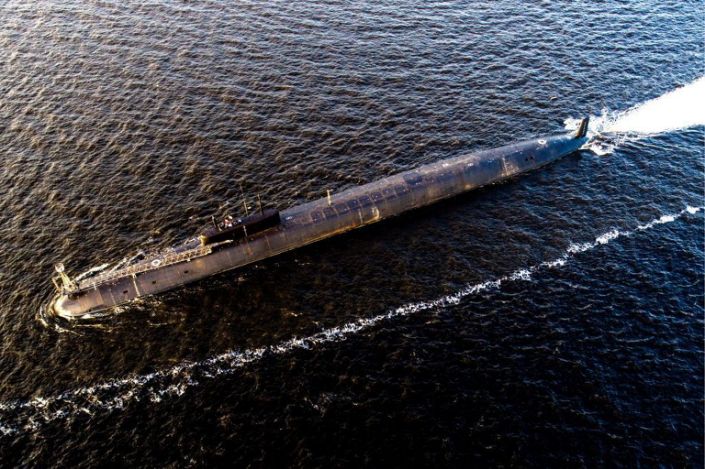It looks like an exotic sea creature.
- The designs for Russia’s next class of nuclear attack submarine, the Laika class, were recently revealed.
- The Laika ships will replace the existing Alfa-class boats, which have been in production for nearly 50 years.
- The new submarines will embark regular guided torpedoes, anti-ship missiles, and land attack cruise missiles.
Russia is preparing to begin work on a brand new class of nuclear-powered attack submarine designed to compete with the best of NATO’s submarines. The new Laika-class submarine, named after a breed of Siberian snow dog, is Moscow’s first clean sheet nuclear attack sub in nearly 50 years. But we don’t know how long it will take to develop the sub—or how many the Russian Navy will eventually receive.
The Russian Federation retains one of the largest submarine fleets in the world, including nuclear and conventional attack submarines, guided missile submarines armed with cruise missiles, and ballistic missile submarines armed with long range nuclear weapons. Although large, the fleet has a secret: many of the ships are decades old and in need of replacement. Of the 16 nuclear-powered attack submarines in operation, almost all were built by the Soviet Union before the end of the Cold War.
The submarine arm of the Russian Navy, like most of the Russian military, suffered for decades after the end of the Soviet Union. Only recently has the submarine force gained new ships, including the new Borei-class ballistic missile submarines and Yasen-class guided missile submarines. Like the USSR, Russia considers submarines useful in a rivalry with the West, as they could threaten U.S. aircraft carriers and threaten enemy shipping.
The Laika class is the third new post-Cold War submarine scheduled to enter production and will replace the Akula (“Shark”) and Victor (NATO code name) submarine classes. According to submarine authority H.I. Sutton, author of the Covert Shores website and contributor at Naval News, the Laika class will incorporate many new design features to allow Russia’s attack submarine fleet to catch up to western standards.
The Laika class is being developed by the Malachite design Bureau in St. Petersburg, Russia. The submarines will displace 11,340 tons, making them considerably larger than the U.S. Navy’s current Virginia class submarines at 8,700 tons. Sutton reports the nuclear-powered submarine will have a top speed of 35 knots, or about the equivalent of 40 miles per hour on land. It will have a maximum dive capability of 1,698 feet. The maximum depth of the Virginia class is secret, but it’s known to be at least 800 feet, and probably closer to 1,600 feet.
The new submarine is in line with Russian submarines in having more of an “organic” look than many western subs. While U.S. submarines have large, conspicuous sails and a tubular, almost pencil-like design, Russian submarines tend to have thicker, wider hulls and a lower, longer sail. As a result, Russian subs tend to look more like exotic sea creatures than their American, British, and French counterparts.
The submarines have some catching up to do and will feature a conformal sonar array that wraps around the hull, providing sound detection in all directions. The submarine likely has about eight 533-millimeter (21-inch) torpedo tubes, the size standard used by navies worldwide, including the U.S. Navy. The torpedo tubes will launch heavyweight guided torpedoes for use against other submarines and surface ships. The submarines will also have up to 16 vertical launch missile silos for Kh-35 anti-ship missiles and Klub land attack cruise missiles.
Russia plans to replace its aging Akula- and Victor-class submarines on more or less of a 1:1 basis, which means about a dozen Laika boats. That depends, however, on how trouble-free the development of this new class of submarines is, and the health of the Russian economy. Moscow’s Borei- and Yasen-class missile submarines each spent nearly two decades in development due not only to their complexity, but a lack of funds to complete production, too. While Russia’s economy has since improved, a global economic downturn, Western sanctions over Moscow’s assassination campaign abroad, and annexation of the Crimea could threaten economic growth.













![Hotstar Premium Cookies 2019 [*100% Working & Daily Updated*] Hotstar Premium Cookies 2019 [*100% Working & Daily Updated*]](https://tahav.com/wp-content/uploads/2019/11/Hotstar-Premium-Cookies-Free-100x70.jpg)



